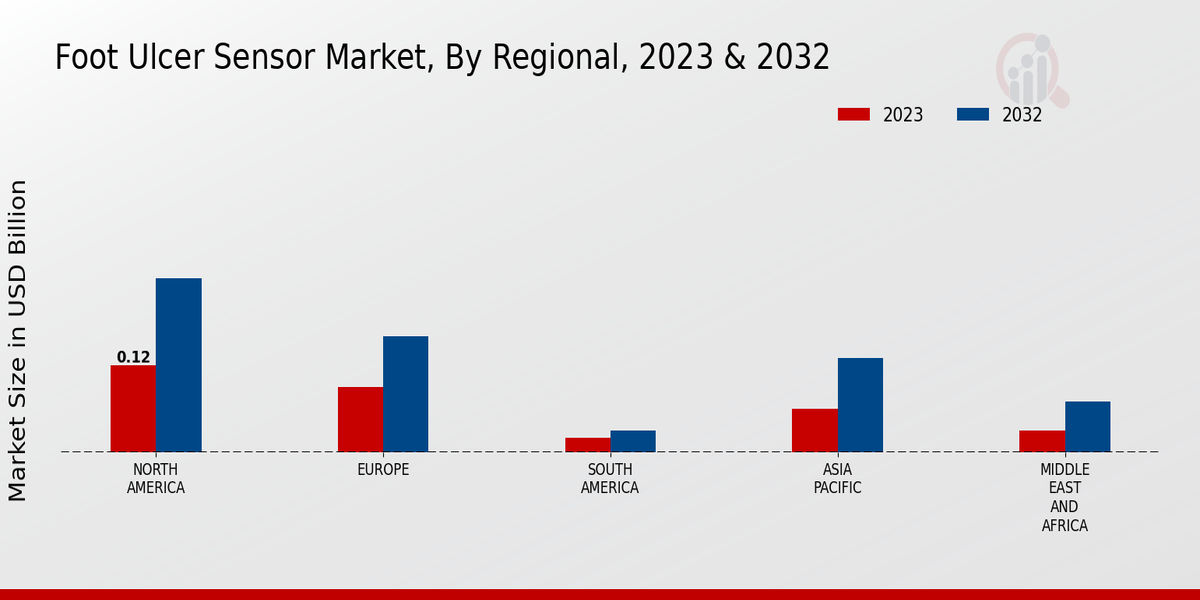Market Growth Projections
The Global Foot Ulcer Sensor Market Industry is projected to experience substantial growth in the coming years. The market is expected to reach 0.24 USD Billion in 2024 and is anticipated to grow to 0.62 USD Billion by 2035. This growth represents a compound annual growth rate of 9.02% from 2025 to 2035. Factors contributing to this growth include the rising prevalence of diabetes, advancements in sensor technology, and increasing awareness of preventive healthcare. As the market evolves, it is likely to attract investments and innovations aimed at improving foot health management, ultimately benefiting patients and healthcare systems alike.
Rising Prevalence of Diabetes
The increasing incidence of diabetes globally is a primary driver for the Global Foot Ulcer Sensor Market Industry. Diabetes is known to cause neuropathy and poor circulation, leading to foot ulcers. According to health statistics, approximately 463 million adults were living with diabetes in 2019, and this number is projected to rise significantly. As a result, the demand for effective monitoring solutions, such as foot ulcer sensors, is expected to grow. The market is anticipated to reach 0.24 USD Billion in 2024, reflecting the urgent need for innovative technologies to prevent complications associated with diabetic foot ulcers.
Integration of Telehealth Solutions
The integration of telehealth solutions into healthcare systems is emerging as a significant driver for the Global Foot Ulcer Sensor Market Industry. Telehealth facilitates remote monitoring and consultations, allowing patients to receive timely care without the need for frequent in-person visits. This is particularly beneficial for individuals with mobility challenges or those living in remote areas. Foot ulcer sensors can be integrated into telehealth platforms, enabling healthcare providers to monitor patients' conditions in real-time. As telehealth continues to gain acceptance, the demand for connected devices, including foot ulcer sensors, is expected to increase, thereby enhancing patient care and outcomes.
Growing Awareness of Preventive Healthcare
There is a notable increase in awareness regarding preventive healthcare, which is significantly influencing the Global Foot Ulcer Sensor Market Industry. Patients and healthcare professionals are increasingly recognizing the importance of early detection and management of foot ulcers. Educational initiatives and campaigns aimed at promoting foot care among at-risk populations, particularly those with diabetes, are gaining traction. This shift towards preventive measures is likely to drive demand for foot ulcer sensors, as they provide essential data for proactive management. As the market evolves, the focus on preventive healthcare is expected to contribute to the projected growth to 0.62 USD Billion by 2035.
Aging Population and Associated Health Issues
The global aging population is a critical factor driving the Global Foot Ulcer Sensor Market Industry. As individuals age, they often experience a decline in mobility and circulation, increasing the risk of foot ulcers. The World Health Organization estimates that the number of people aged 60 years and older will reach 2 billion by 2050. This demographic shift necessitates the development of effective monitoring solutions to manage foot health. Consequently, the demand for foot ulcer sensors is likely to rise, as these devices can help mitigate the risks associated with aging. The market's growth trajectory is expected to align with the increasing healthcare needs of this population.
Technological Advancements in Sensor Technology
Advancements in sensor technology are propelling the Global Foot Ulcer Sensor Market Industry forward. Innovations in materials and miniaturization have led to the development of more accurate and user-friendly sensors. These devices can now provide real-time data on foot conditions, enabling timely interventions. For instance, wearable sensors that monitor pressure and temperature can alert patients and healthcare providers to potential ulcer formation. This technological evolution is likely to enhance patient outcomes and reduce healthcare costs, further driving market growth. The anticipated compound annual growth rate of 9.02% from 2025 to 2035 underscores the potential of these advancements.



 Source: Primary Research, Secondary Research, Market Research Future Database and Analyst Review
Source: Primary Research, Secondary Research, Market Research Future Database and Analyst Review













